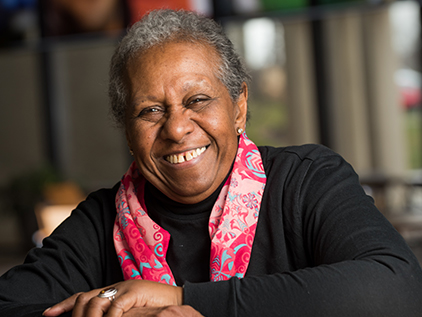- Home
- Types & Treatments
- Breast Cancer
- Types of Breast Cancer
- Triple-Negative Breast Cancer
Breast Cancer
Triple-Negative Breast Cancer
One of the rarest types of breast cancer, triple-negative breast cancer represents between 10% to 20% of all breast cancers. Triple-negative breast cancer symptoms can be more aggressive and is more likely to recur than other breast cancers. It derives its name from the lack of receptors for estrogen, progesterone and HER2. The absence of these receptors rules out proven hormone therapies such as tamoxifen.
The University of Kansas Cancer Center Cancer researchers are developing clinical trials to evaluate new treatments for triple-negative breast cancer, such as immunotherapy, DNA-damaging chemotherapy and PARP inhibitors (targeted drug therapy).
Genetic risks of triple-negative breast cancer
The main demographics for triple-negative breast cancer diagnosis are younger women (between the ages of 40 and 50), African-American and Hispanic women, and people with a BRCA1 mutation. About 15% to 20% of women with a triple-negative breast cancer prognosis have a genetic mutation. That means these women are at risk for other cancers and their family members could be at risk for cancers as well. Our team encourages women to talk with their providers about genetic counseling and testing.
Treating triple-negative breast cancer
Unlike other subtypes of breast cancer that are defined by the presence of certain biomarkers, triple-negative breast cancer is defined by the absence of those markers (estrogen receptors, progesterone receptors and HER2 protein). Since other breast cancer treatments are based on targeting biomarkers, the lack of these markers in triple-negative breast cancer makes finding an effective treatment challenging.
Besides not having targetable biomarkers, one of the other challenges with triple-negative breast cancer treatment has been that chemotherapy treatment options have not changed significantly in the last decade. Although it is clear that triple-negative breast cancer is very different from other types of breast cancer, the standard has been to use the same chemotherapy for all subtypes of breast cancers.
Advances in triple-negative breast cancer treatments
Today, the use of immunotherapy is creating new hope for treating triple-negative breast cancer. Research has shown that immunotherapy is very helpful in curing patients with melanoma and lung cancer, but we are now realizing that triple-negative breast cancer is also sensitive to immunotherapy.
Immunotherapy uses the body’s own immune system to fight cancer. A type of cell in the immune system known as the T cell can scan for and kill cancer cells. However, cancer cells secrete substances that limit the T cells’ ability to find them. Immunotherapy helps the T cells locate and attack the cancer cells again. Adding immunotherapy to chemotherapy has almost doubled survival rates in women with stage 4 triple-negative breast cancer.
Hear Our Stories
Find a clinical trial.
Clinical trials give you an opportunity to try new therapies that might not otherwise be available. Search our clinical trials.



